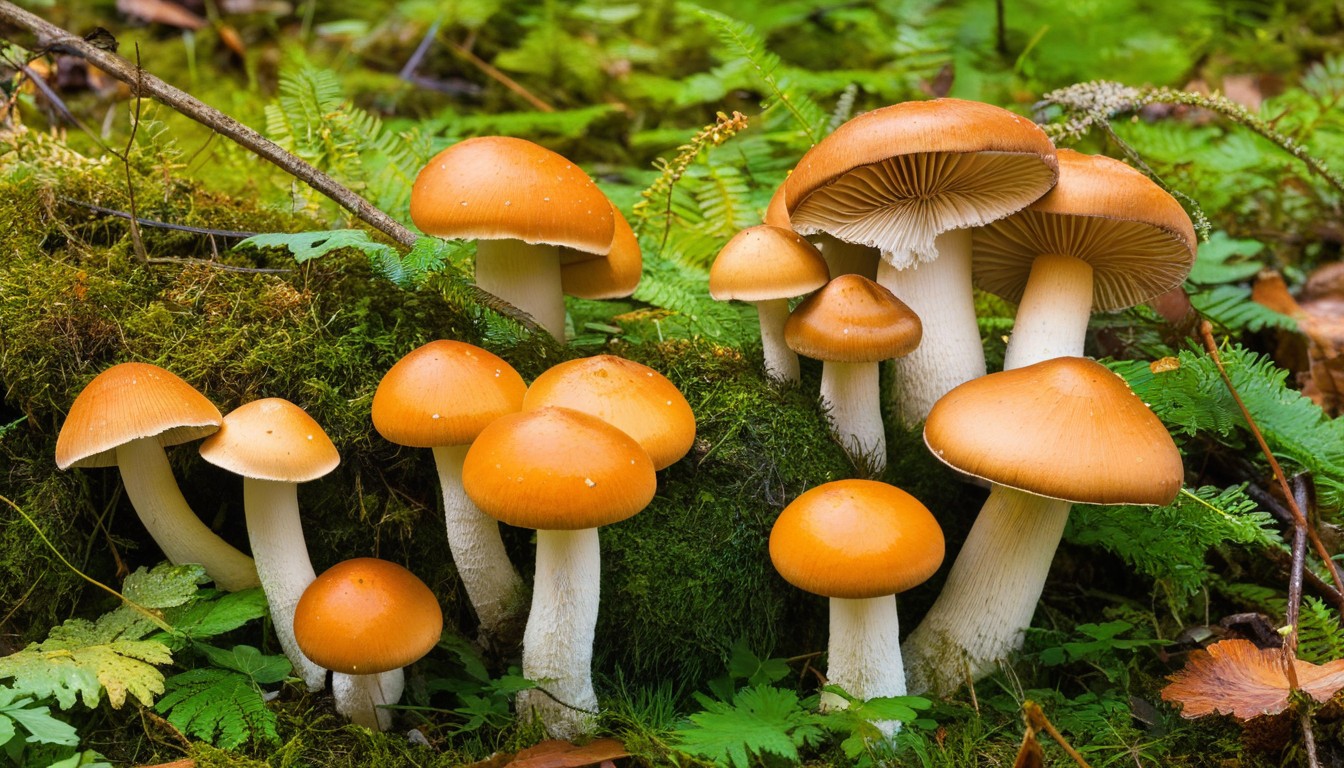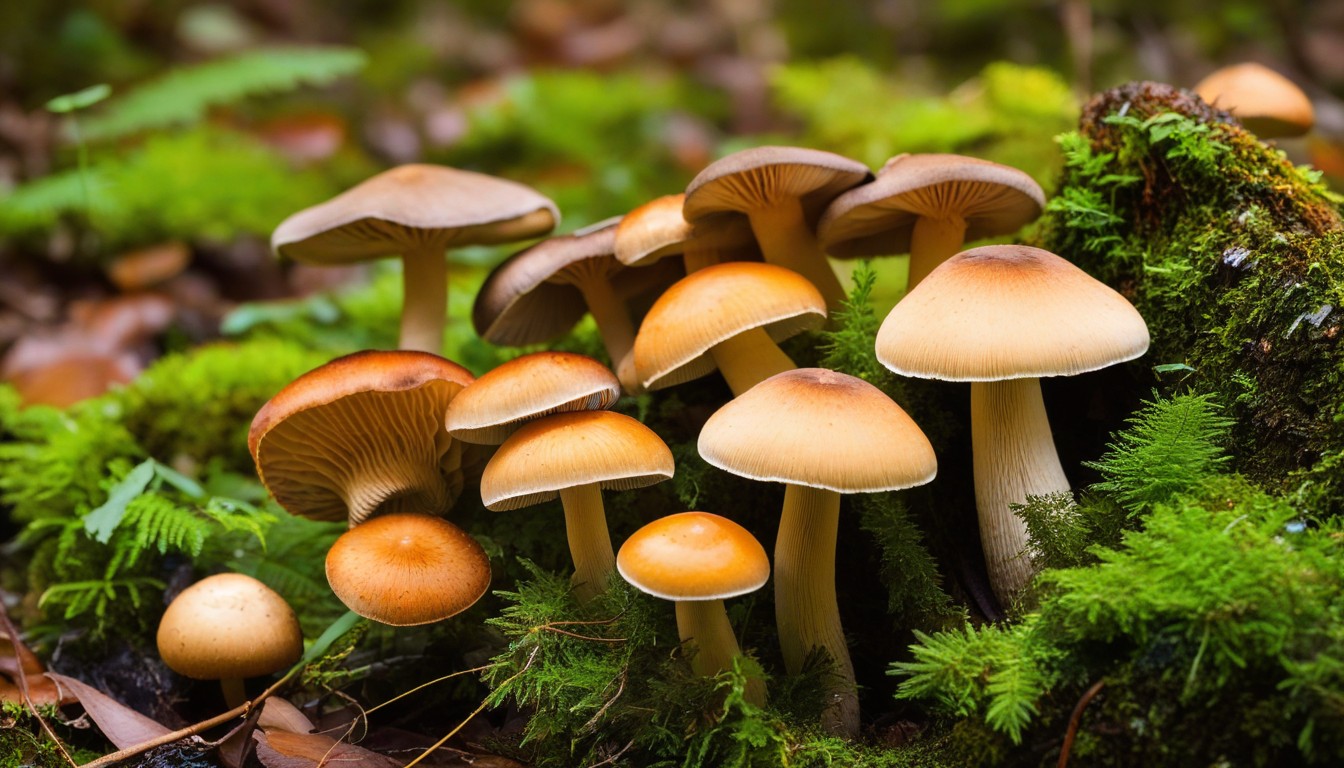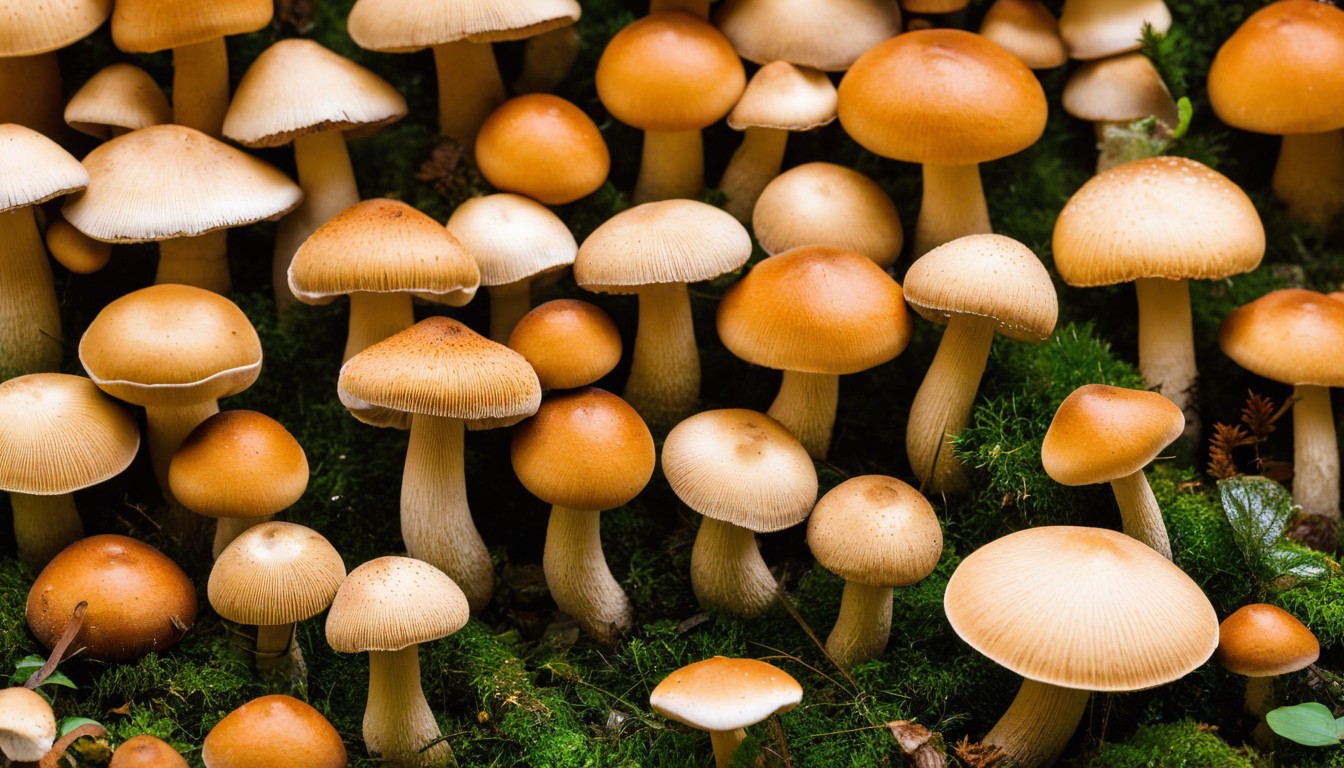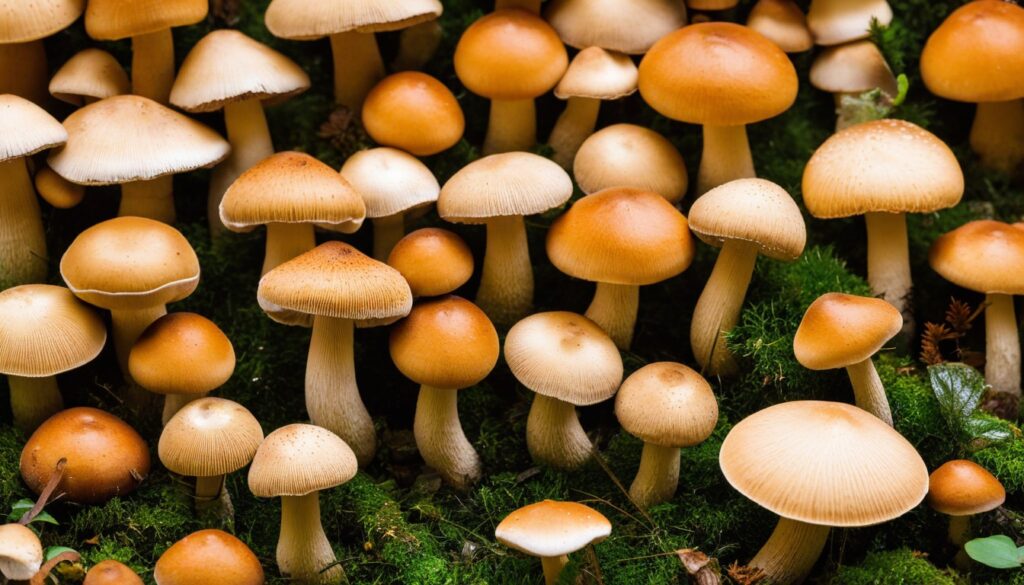Georgia is a forager’s paradise, offering a diverse range of edible mushrooms for those looking to explore the natural world. From the rolling hills in the north to the flat coastal plains in the south, there’s no shortage of fascinating fungi to discover.
In this comprehensive guide, we’ll delve into the world of edible mushrooms in Georgia, learning about the most common species, some hidden gems, and invaluable tips from experienced foragers.
Key Takeaways
- Georgia is home to a variety of edible mushrooms suitable for foraging.
- It’s important to understand the fundamentals of mushroom foraging, including safety precautions and ethical practices.
- Some popular edible mushrooms in Georgia include the Morel and Chanterelle, but there are many lesser-known options available.
- Combining foraging knowledge with the right cooking techniques can elevate the flavors and textures of these delicious mushrooms.
- Before engaging in mushroom foraging activities, be aware of the legal considerations and potential risks associated with consuming poisonous mushrooms.
Mushroom Foraging Basics
Are you ready to embark on a mushroom foraging adventure? Before setting foot in the woods, it’s essential to understand the fundamentals of foraging. By following these mushroom foraging basics, you’ll be better equipped to locate and identify edible species safely and effectively.
Gear Up for Success
First and foremost, you’ll need to gather the right equipment. Bring a basket or breathable container for your harvested mushrooms, a reliable knife for cutting the stem cleanly, and a sturdy pair of hiking boots for navigating uneven terrain. Don’t forget to dress appropriately for the weather and to bring along a map, compass, and GPS device for navigation.
Safety First
Mushroom foraging can be a safe and enjoyable activity, but it also comes with potential hazards. Be mindful of your surroundings and watch out for potential dangers, such as poisonous plants and venomous snakes. Always carry a first-aid kit and familiarize yourself with common illnesses and symptoms caused by poisonous mushrooms to act quickly in case of poisoning. Also, do not eat anything unless you are 100% sure it is safe to consume.
Ethical Practices
Respect the environment when foraging by avoiding over-harvesting, not disturbing wildlife habitats, and closing any gates you open. It is also crucial to confirm that you are allowed to forage in the area you are visiting since laws and regulations may vary. Some parks or protected areas may have strict rules about collecting mushrooms, so do your research beforehand.
Identifying Suitable Habitat
Mushrooms grow in different environments, so it’s important to identify the right habitat for the species you’re looking for. Some require acidic soil, while others prefer rotting wood or mossy areas. Also, keep in mind that seasonality plays a critical factor, so brush up on the growing season of the species you want to find. Consult with local resources like park rangers, environmentalists, or expert foragers to understand the intricacies of mushroom identification and characteristics of edible mushrooms.
Popular Edible Mushrooms in Georgia
Georgia is a treasure trove of edible mushrooms, offering a diverse range of species to forage. Here, we will introduce you to some of the most popular and sought-after edible mushrooms in the region, along with tips on how to identify and harvest them.
|
Mushroom Name |
Description |
Harvest Season |
Best Habitat |
|---|---|---|---|
|
Morel |
One of the most prized edible mushrooms in Georgia, the Morel has a nutty, meaty flavor with a distinct honeycomb texture. |
Spring (March to May) |
Moist, wooded areas with rich soil, especially around ash, tulip, and oak trees. |
|
Chanterelle |
The golden-orange funnel-shaped cap of the Chanterelle has a fruity, earthy aroma and a slightly nutty taste that pairs well with meats and seafood. |
Summer to fall (June to November) |
Moderately damp, mossy environments, such as deciduous or coniferous forests, near stream beds or damp gullies. |
|
Hen of the Woods |
Also known as Maitake, this mushroom has a meaty texture and a rich, umami flavor that pairs well with pasta dishes and stir-fries. |
Summer to fall (August to November) |
Grows at the base of hardwood trees, such as oak or elm, in wooded areas, and often found in clusters. |
|
This vibrant, reddish-orange mushroom gets its name from its seafood-like taste and texture, making it a delightful addition to seafood dishes and stews. |
Late summer to fall (August to October) |
Grows parasitically on other mushrooms, often Russula or Lactarius mushrooms, and thrives in forests and meadows. |
These tantalizing mushroom species can be found throughout Georgia’s forests and wooded areas. Take the time to learn about these popular edible mushrooms and discover which ones appeal most to your palate. Happy foraging!
Lesser-Known Edible Treasures

While Morels and Chanterelles are well-known among foragers in Georgia, there are other equally delicious mushrooms waiting to be discovered. Expand your palate and find new culinary inspirations with these hidden gems. Here are a few varieties to keep an eye out for:
|
Mushroom Name |
Description |
|---|---|
|
Porcini |
A meaty mushroom with a nutty flavor, Porcini can grow to be quite large and are often found in hardwood forests. |
|
Hedgehog Mushroom |
These small, toothy mushrooms have a delicate flavor and are often found growing in coniferous and mixed forests. |
|
Lion’s Mane |
A distinctive mushroom with a shaggy appearance, Lion’s Mane has a mild, seafood-like flavor and is often found on hardwood trees. |
These are just a few of the many lesser-known edible mushrooms you can find in Georgia. As always, make sure to properly identify any mushroom harvested before consuming it and follow ethical foraging practices to ensure sustainability.
Tips for Successful Mushroom Foraging in Georgia

Foraging for mushrooms in Georgia can be an exhilarating experience for anyone who enjoys the thrill of the hunt. However, it’s essential to have the right knowledge and techniques to maximize your success while minimizing the risks. Here are some valuable mushroom foraging tips to help you make the most of your adventure:
1. Identify Suitable Mushroom Habitats
Mushrooms thrive in damp environments, which makes the forests, wooded trails, and parks in Georgia the perfect spot to find them. Look for lush greenery, fallen leaves, and decayed trees, as they provide the ideal conditions for mushroom growth.
2. Learn How to Identify Edible Mushrooms
Identifying the right mushrooms can be tricky, especially if you’re new to the hobby. It’s essential to learn about the different mushroom species and their distinctive features, such as shape, color, and texture. Consider using a field guide or attending a mushroom foraging workshop to improve your identification skills.
3. Time Your Foraging Expedition Correctly
The best time to forage for mushrooms in Georgia is during the late spring, summer, and fall seasons. Warm temperatures and high humidity provide the ideal conditions for mushroom growth. However, it’s best to avoid foraging after heavy rainfall, as it can cause an abundance of toxic mushrooms to sprout.
4. Practice Ethical and Sustainable Foraging
Ensure that you follow ethical and sustainable practices when foraging for mushrooms. Avoid picking all the mushrooms in one area or damaging the habitat as it may impact other organisms in the ecosystem. Take only what you need and leave the rest for others and future generations to enjoy.
“Mushroom foraging is a skill that takes a while to master. Take your time, stay patient and persistent, and always prioritize safety and sustainability.”
Poisonous Mushrooms to Avoid

While mushroom foraging can be a fun and rewarding activity, it’s important to exercise caution and be aware of the potential risks associated with consuming poisonous mushrooms. In Georgia, there are several toxic mushroom species that foragers should avoid at all costs due to their high toxicity levels.
Amanita phalloides (Death Cap)
The Death Cap mushroom is a deadly fungus commonly found in Georgia. It contains amatoxins that cause liver and kidney failure, leading to severe complications and even death. The mushroom has a distinctive appearance, with a greenish-white cap and a white stem.
Galerina Marginata (Deadly Galerina)
The Deadly Galerina is a small, brown mushroom that can be found in forests and wooded areas in Georgia. It contains amatoxins that cause liver damage and can be fatal if ingested in large quantities. This mushroom is often mistaken for the edible Honey Mushroom, so careful identification is crucial.
Conocybe filaris (Conocybe Mushroom)
The Conocybe Mushroom is a slender, brown mushroom that is commonly mistaken for the edible Paddy Straw Mushroom. However, it contains the toxin amatoxin, which can cause liver failure and even death. It’s essential to correctly identify this mushroom species before consumption.
Remember, it’s vital to educate yourself on the identification and characteristics of edible mushrooms before planning a foraging trip. Always consult with an expert or reputable guide to ensure your safety while exploring the fascinating world of mushroom foraging in Georgia.
Cooking and Preserving Mushrooms
Now that you have collected your bountiful harvest, it’s time to explore the delicious culinary possibilities that these Georgia mushrooms have to offer. Luckily, these mushrooms are versatile and can be cooked in a variety of ways.
Cooking Methods
Mushrooms can be sautéed, roasted, grilled, or even fried. Sautéing is a common method that brings out their earthy flavor. Roasting is perfect for a low-maintenance cooking method that brings out their natural sweetness. Grilling adds an amazing smoky flavor, while frying gives them a crispy texture.
|
Cooking Method |
Description |
|---|---|
|
Sautéing |
Quick cooking method that enhances the earthy flavor of mushrooms. |
|
Roasting |
Low-maintenance cooking method that brings out the sweetness of mushrooms. |
|
Grilling |
Adds a smoky flavor and char on the mushrooms. |
|
Frying |
Gives mushrooms a crispy texture. |
Recipes
Mushrooms can be added to many dishes to give them depth and flavor. Sautéed mushrooms are a great addition to pasta, risotto, or pizza. Roasted mushrooms can be added to salads or used as a side dish. Grilled mushrooms are perfect as a topping for burgers or in a salad. Fried mushrooms make a tasty appetizer or a topping for a sandwich.
- Sautéed Mushroom and Spinach Pasta
- Risotto with Roasted Mushrooms
- Mixed Greens Salad with Roasted Mushroom and Shallot Vinaigrette
- Portobello and Swiss Burger with Grilled Onions and Mushrooms
- Fried Mushroom Bruschetta
Preservation Techniques
If you can’t eat all the mushrooms right away, there are ways to preserve them for later use. One method is to simply dry them in the sun or a dehydrator, which saves them for months in a sealed container. Another is to freeze them by cooking them first and then placing them in freezer bags to lock in their flavor and nutrients. Lastly, they can also be canned in jars using a pressure cooker or boiling water bath.
With these cooking and preservation techniques, you can enjoy the delicious flavors of Georgia’s abundant mushrooms all year long.
Mushroom Foraging Communities and Events in Georgia

Are you looking to connect with other mushroom foragers in Georgia? Look no further than the numerous mushroom foraging communities and events available throughout the state. Joining a community is a great way to expand your knowledge and meet likeminded foragers.
Here are a few top mushroom foraging communities in Georgia:
|
Name |
Description |
Location |
|---|---|---|
|
Savannah Mushroom Club |
A community focused on educating the public about local wild mushrooms and promoting sustainable foraging practices. |
Savannah |
|
North Georgia Mushroom Club |
A club dedicated to educating members about local mushrooms and leading forays throughout the north Georgia mountains. |
North Georgia |
|
Piedmont Mushroom Club |
A community focused on foraging and identifying edible and medicinal mushrooms in the Piedmont area of Georgia. |
Piedmont region |
In addition to joining a community, you can also participate in foraging events throughout Georgia. These events offer the opportunity to learn from experienced foragers and discover new mushroom spots in the area. Here are a few popular foraging events in Georgia:
- North Georgia Wild Foods Festival
- Georgia Mushroom Festival
- Atlanta Mycological Society Foray
Don’t miss out on the chance to connect with other mushroom foragers and deepen your knowledge of local species. Join a community or attend an event today!
Legal Considerations and Conservation Efforts
Mushroom foraging is a popular activity but is subject to certain regulations in Georgia to ensure the sustainability of our natural ecosystems. It is important to be aware of these regulations when embarking on a mushroom foraging adventure.
Mushroom Foraging Regulations
Georgia law requires foragers to obtain written permission from private landowners before foraging on their property. Public land, however, is open for mushroom foraging. It is essential to research federal and state regulations, such as the National Forests mushroom permit system or state parks regulations, as they vary across the region. Always carry a copy of the regulations while foraging in public areas and be sure to adhere to the guidelines to minimize negative impacts on the environment.
Conservation Efforts in Georgia
Conservationists in Georgia have been working diligently to protect the state’s natural resources and preserve habitats for native species. It is crucial to follow ethical practices when foraging, such as leaving no trace, avoiding over-harvesting, and respecting wildlife and their habitats. As a forager, you can also contribute to conservation efforts by reporting invasive or rare species, volunteering with local organizations, and supporting sustainable practices that protect the environment.
“Mushroom foraging is a unique and rewarding experience that allows us to connect with nature and savor the fruits of the forest. By respecting the laws and conserving our environment, we can continue to enjoy this activity for generations to come.”
Conclusion
In conclusion, Georgia’s rich natural landscape is home to an abundant array of edible mushrooms that are just waiting to be discovered. Armed with the knowledge shared in this guide, you can embark on your own mushroom foraging adventures and explore the diverse forests and trails of Georgia. Remember to prioritize safety, ethical practices, and the preservation of these natural treasures as you enjoy the world of edible mushrooms in Georgia. Happy foraging!
FAQ
What are some popular edible mushrooms found in Georgia?
Some popular edible mushrooms found in Georgia include Morel, Chanterelle, and Chicken of the Woods. These species are prized by foragers for their delicious flavors and culinary versatility.
Are there any lesser-known edible mushrooms in Georgia?
Yes, Georgia is teeming with lesser-known edible mushrooms that offer unique flavors and textures. Some examples include Lion’s Mane, Maitake, and Blewit. Exploring these hidden gems can enhance your culinary adventures.
What are some tips for successful mushroom foraging in Georgia?
To increase your chances of finding edible mushrooms in Georgia, it’s important to develop your mushroom identification skills, forage during the appropriate season, and practice sustainable foraging techniques. Additionally, joining local mushroom foraging communities and events can provide valuable insights and knowledge sharing.
How can I differentiate between edible and poisonous mushrooms in Georgia?
Differentiating between edible and poisonous mushrooms requires knowledge and experience. It’s essential to properly identify mushrooms using field guides, consult with knowledgeable foragers, and err on the side of caution when unsure. It is crucial to be aware of common toxic mushrooms found in Georgia to ensure foraging safety.
What are some cooking and preservation techniques for mushrooms found in Georgia?
There are various ways to cook and preserve mushrooms found in Georgia. You can sauté them, roast them, use them in soups or stews, or even pickle them. Properly drying and freezing mushrooms are effective preservation methods. Discover delightful recipes and techniques to savor the flavors of your foraged treasures.
Are there any mushroom foraging communities or events in Georgia?
Yes, Georgia has vibrant mushroom foraging communities and events. Joining these communities and participating in forays is an excellent way to connect with experienced foragers, learn from their expertise, and share your own discoveries. These interactions can greatly enrich your mushroom foraging experience.
Are there any legal considerations when foraging for mushrooms in Georgia?
Yes, mushroom foraging in Georgia is subject to certain regulations to protect the sustainability of the ecosystem. It’s important to familiarize yourself with these regulations and adhere to them while engaging in foraging activities. Additionally, it’s crucial to contribute to conservation efforts to preserve these valuable natural resources for future generations.

